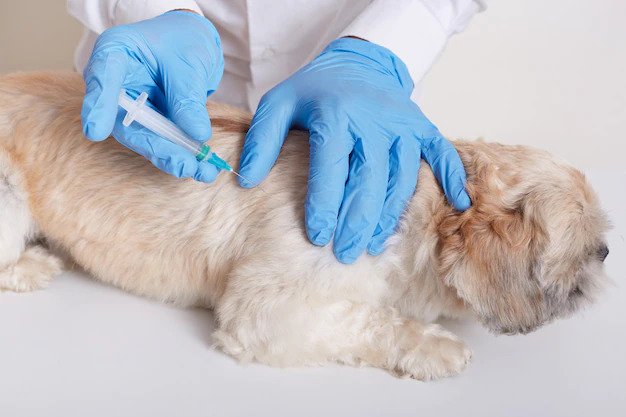2022-10-18
Bringing a new puppy home means never stopping to take care of it and ensuring that it lives a fulfilled and happy life. Dog care is not associated only with a few walks during the day, bathing the dog from time to time based on his/her breed, and not forgetting to feed him/her... Real care means a constant effort in arranging a safe and loving environment, feeding the dog with quality food, keeping him/her engaged in physical and mental activities, paying attention to him/her, and properly addressing behavioral issues so that the dog remains calm and motivated to improve his/her behavior and regularly taking him/her for veterinarian checks.
Bringing your paw friend to the veterinarian's office is usually paired with negative emotions. However, responsible owners should make sure that their doggy is vaccinated, and has gone through parasite control. This is essential for dogs to remain healthy and live long. There are many health conditions, some of which are breed-related, and genetically inherited others are caused by bacterial and viral infections and are often transmitted from other animals. Luckily many of these illnesses are treatable.
We will let you know what illnesses can be very dangerous for your paw friend if you do not get him/her vaccinated and will also give you some tips on how a vaccination schedule may look.

Rabies is an illness that affects the central nervous system in mammals and is transmitted through direct contact with the infected animal. Usually, it is transmitted through saliva or a tissue of the animal’s nervous system. It may take from 2 weeks to a few months for the first signs of rabies to become visible. Symptoms of this disease are excessive drooling, difficulty swallowing, staggering, and even fever and paralysis. If the virus gets to the brain, it multiplies and reaches the salivary glands. From this point on animals start showing symptoms of the disease and usually die within 7 days.
Canine distemper is a highly contagious viral disease, that affects the nervous, respiratory, and gastrointestinal systems of dogs. However, it has also been reported in wild animals such as wolves, coyotes, foxes, raccoons, tigers, lions, and seals. Symptoms of this illness are typically eye discharge (usually it looks like pus), nasal discharge, coughing, vomiting, as well as a decreased energy level in general and loss of appetite. The virus can be transmitted through airborne exposure, shared feeding supplies, and also through the mother’s placenta. Unfortunately, there is no cure for this disease. However, it can be treated with supportive care and actions to manage the symptoms and prevent further infections.
There are two types of this disease:
1. Infectious Canine Hepatitis;
2. Chronic Hepatitis.
The first type is a viral (caused by adenovirus 1) acute disease, that is highly contagious. It usually attacks the lungs, liver, kidneys, spleen, and lining of blood vessels and can also affect other organs. Accompanying symptoms can be thirst, fever, lethargy, blindness, eye inflammation, enlarged tonsils, depression, and even death.
Chronic hepatitis is associated with an infection that has been damaging cells for at least several weeks. It is related to the first type, as at some point the disease may reach the liver, causing inflammation which can lead to necrosis.
Dogs who managed to survive may experience clouding in the eye’s cornea and even more serious reactions such as kidney damage. There are records of dogs who were cured of acute canine hepatitis, however, chronic hepatitis is not curable.
This is a contagious virus that is especially dangerous for unvaccinated pups younger than 4 months old. This virus attacks gastrointestinal tracts in dogs and is transmitted through contact with an infected dog, his/her feces; through people (hands or clothing of people who have physical contact with infected dogs); contaminated environments such as food/water bowls and training equipment, shoes, carriers, and other items. Symptoms that accompany this virus can be vomiting, diarrhea, fatigue, abdominal pain, and hypothermia. Vomiting and diarrhea can lead to dehydration and cause death if remain untreated for 48-72 hours. Taking care of your paw friend to stay hydrated is crucial for his/her survival.
Bordetella is a highly contagious respiratory disease in dogs, that is usually associated with the so-called kennel cough in dogs. It is caused by the bacteria Bordetella bronchiseptica and can lead not only to severe coughing, but also to vomiting, watery nasal discharge, fever., retching, pneumonia, and fatigue. This disease can be spread through direct contact, airborne exposure, or contaminated objects. Also, it can be transmitted from dogs to cats and vice versa.
By "kennel cough" is meant a highly contagious respiratory disease, the main symptom of which is coughing. Other symptoms that can accompany this disease are lethargy, nasal discharge, loss of appetite, and fever. Kennel cough is also known as „infectious tracheobronchitis“, which implies what parts of the respiratory system are affected by this disease, namely the trachea and the bronchial tubes. It usually affects dogs in places such as parks, daycare facilities, training groups, or other areas where there are many dogs at the same place. This illness can be transmitted from one dog to another through direct contact, airborne exposure, or infected objects and surfaces. Fortunately, this disease is curable and mild cases can be treated within 1-2 weeks with proper medication.

This virus is one of the most common pathogens of canine cough. It is highly contagious and is usually accompanied by coughing, nasal discharge, vomiting, fatigue, fever (mostly low-grade), and loss of appetite.
This is an infection caused by the bacteria Leptospira, which can be found in water and soil. Leptospirosis is a type of the so-called zoonotic disease, which means that it can be transmitted from animals to humans. Possible symptoms in people are flu-like, but can also be kidney and liver disease. However, there are rare cases when this disease has been transferred from an infected animal to a human. Canines infected with this disease can have the following accompanied symptoms: dehydration, vomiting, swollen legs, thirst, changes in the frequency of urination, fatigue, eye inflammation, kidney or liver failure, as well as a bleeding disorder. This condition can be treated- usually with medication and supportive care. However, in some cases, it permanently affects the kidneys and the liver.
This disease is caused by the bacterium Borrelia burgdorferi, and can be transmitted to both animals and humans through infected ticks. Common symptoms of Lyme Disease are lethargy, loss of appetite, swollen lymph nodes, and lameness. Between 5-10% of the infected animals are expected to show signs of the disease. These signs usually become visible at the chronic stage of the disease, which can be up to 5 months or even later after infection.
Heartworm disease also known as dirofilariasis is a serious disease, spread through a mosquito bite. It can affect the lungs, the heart, as well as other organs and even cause death. These parasites can be found in the pulmonary vessels, the heart, and the blood vessels of infected canines. However, they can also get to other organs such as the kidney and the liver. Adult worms can reach up to 14 inches in length and obstruct the normal functioning of organs. Accompanying symptoms can be lethargy, coughing, loss of appetite, and decreased energy level in general. The later the stage of the disease is, the more serious the symptoms get, namely bloating and heart failure. Since these parasites are transmitted through a mosquito bite, a blood test should be run for them to be detected.
We would like to note that this is not the same virus that is responsible for COVID-19 in humans. The first records of Coronavirus in dogs can be tracked down to the 70s.
Canine Enteric Coronavirus (CECoV) is an intestinal infection that is typically transmitted through contact (oral) with infected feces. It mostly affects puppies and can cause diarrhea, vomiting, fatigue, and loss of appetite.
Canine Respiratory Coronavirus (CRCoV) is a type of respiratory infection in dogs that can be transmitted through direct contact with infected canines.
You will find below an optional dog vaccination schedule.
Please consult your veterinarian for information about the mandatory and optional dog vaccines that your dog should get.

Vaccination against Distemper and Parvovirus;
Optional vaccination against Bordetella.
Vaccination against DHPP- Distemper, Hepatitis, Patainfluenza, Parvovirus;
Optional vaccination against Leptospirosis, Bordetella, Lyme Disease, Influenza based on the location and lifestyle.
Vaccination against rabies and DHPP;
Optional vaccination against Lyme Disease, Leptospirosis, Influenza, Bordetella.
Vaccination against rabbies and DHPP;
Optional vaccination against Bordetella, Lyme Disease, Coronavirus, Leptospirosis.
Vaccination against DHPP;
Optional vaccination against Lyme Disease, Bordetella, Influenza, Leptospirosis, Coronavirus.
Vaccination against rabbies.